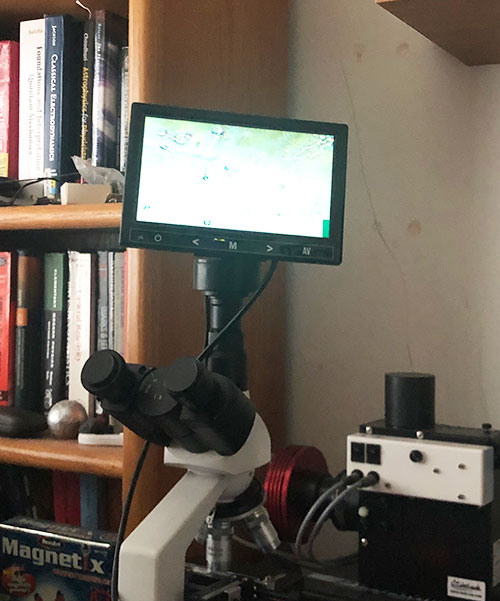Greetings from Palmia Observatory
Well, we finally collected some micrographs and videos of water bears and other living samples.
So, recall from the blog post of January 13, we had received our microscope from Amazon and put our living sample of water bears on the microscope slide. Recall that our microscope is illustrated below.
 |
| Microscope setup used for our search for water bears (Source: Palmia Observatory) |
We first saw examples of water bears, or as they are officially named, Tardigrades, in the video described in the blog post of December 15, 2023, photo from that video is shown below.
 |
| Water Bear example photograph (Teaching Company, "Life in our Universe") |
Well, now that we have our very own microscope we can put the purchased sample of water bears on the microscope slide and take a look. This is one of the first video images of living, moving water bears. The magnification scale is such that the width of the display screen is approximately 1 mm.
Living Water Bears (Source: Palmia Observatory)
One interesting idea that was discussed in our Astrophysics SIG was how water bears could survive in outer space type environments. For example, could they be dried out and then be rejuvenated later by just adding water. Some reports indicate that this has been observed. So the water bears are very hardy little animals.
We tried to repeat this kind of experiment. A sample of living water bears was allowed to dry out on the microscope slide and then later a drop of water was reapplied. A cover slip was put over the sample and the edges of the cover slip were sealed with Vaseline so that the water would not evaporate very quickly. The slide was examined for the next 12 hours, but the water bear sample did not become alive. Here is the micrograph of our sample is one water bear with other unknown material in the solution.
 |
| Water bear specimen after water has been reapplied (Source: Palmia Observatory) |
We did not try to repeat the experiment but wondered what other living specimens we might find. Amazon does not offer any specimens that we could find so considered just getting a drop of blood for examination. But I was reluctant to provide a drop of blood.
But, I considered another source of specimen, and this is kind of embarrassing to admit, but the idea of looking at some living sperm seemed like a good idea. I mean how many of you have seen this for your self. So, since the source was available and easy to get your hands on it, a sample was produced, without any pain I might add, for examination. This video shows the motion of the living specimen. The microscope scale magnification for this video is such that the horizontal display width is about 0.1 mm.
Living Personal Sample (Source: Palmia Observatory)
Ok, that is the extent to trying to look through a microscope rather than a telesccope.
Until next time,
Resident Astronomer George

No comments:
Post a Comment